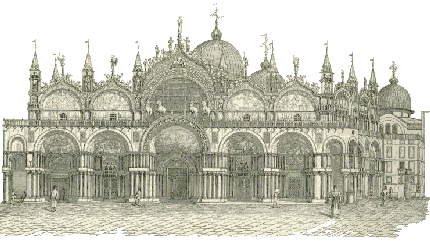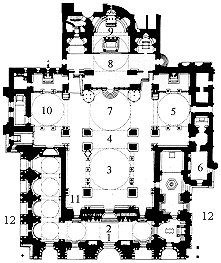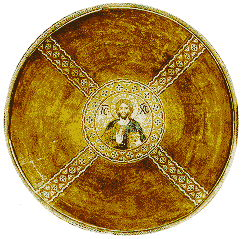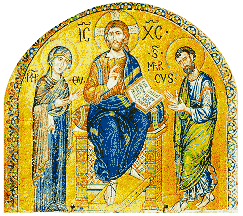Venezia - St. Mark's Basilica

The Basilica of St.Mark the Evangelist, the cathedral church of the city and seat of the Patriarch of Venice since 1807, when it took the place of the former cathedral of San Pietro di Castello, is a living testimony of christian faith.
In particular the mediaeval mosaics, depicting stories and episodes from the Old and New Testaments, are not only a biblical meditation but also - like the ikons of the Eastern Churh - a sign of God's presence in the world.
The present Basilica is the third church to be built on the site, following the one commissioned by doge Giustiniano Partecipazio to celebrate the arrival of the body of St.Mark in Venice in 828, and the X cent. rebuilding ordered by doge Pietro Orseolo I after a fire in 976.
In the second half of the XI cent. doge Domenico Contarini had the church entirely rebuilt on a much larger scale, though using much of the ancient foundations and masonry.
It was consecrated in 1904.

THE INTERIOR
- THE NARTHEX: formerly no more than a simple porch, the Narthex was given its present shape and size during the XII and perhaps early XIII cent.
- THE MAIN DOORWAY: the apsidal doorway may be a relic of the earlier church on the site. The staircase on the right leads to the Galleries (where the original St.Mark's Horses are now housed) and to the Balconies overlooking the Square.
- THE DOME OF THE PENTECOST.
- THE GREAT WEST ARCH.
- THE SOUTH TRANSEPT: the part closest to the Palazzo Ducale, to which the church is linked by a door, through which the doge normally entered St.Mark's.
- THE TREASURY: contains 283 items in gold, silver, glass and other precious materials, the oldest of which were originally booty taken from Constantinople during the IV Crusade (1204). In 1797, at the fall of the Republic, many pieces were destroyed or melted down.
- THE DOME OF THE ASCENSION: is at the centre of the church over the intersection of nave and transepts.
- THE CHANCEL: (entrance from the South Transept through the Chapel of St.Clement) is the area separated from the nave by the Rood Screen, which is traditionally reserved for the clergy during services. The doge also had a throne in the Chancel.
- THE PALA D'ORO: is an altar screen which was placed in its gilded silver frame in the mid-XIV cent. under doge Andrea Dandolo. The precious cloisonn? enamel panels and roundels were probably all made in Byzantium at various times between the X and XII cent.
- THE NORTH TRANSEPT: The Nicopeia Madonna, a Byzantine ikon which Venetians have always venerated, has been in its present position since the altar was made in 1607. At the end of the transept are the Chapel of St.Isidore and the Chapel of the Mascoli.
- ST.PETER'S DOOR.


THE EXTERIOR
The main faзade, originally finished in unfaced brick, was subsequently decorated with marble and columns brought from Constantinople (Byzantium) when the city was conquered by Venetian forces in 1204, during the IV Crusade.
The mosaics in the arches of the upper order and in the lunettes over four of the doors are all seventeenth century reworkings of XIII cent. mosaics (with the exception of the first on the left, the only original work, and the second, which dates from ca. 1730).
The three splayed arches around the central doorway are decorated with fine carvings. The XIII cent. Venetian sculpture shows both eastern and western influences (the latter from Padua and France) and there is a discernible development of style between the inner and outer arches.
On the balcony above the main doorway stand copies of the four horses (the originals are inside the church) which were brought to Venice from the hippodrome in Constantinople and placed in their present position in the second half of the XIII cent., a potent symbol of Venice's view of itself as the heir of the great imperials capitals: Rome (the Western Empire) and Byzantium (the New Rome, capital of the Eastern Empire).
On the faзade facing the water, St.Mark's Basin, there was once an entrance, the Porta da mar, giving access straight from the wharves beside the Palazzo Ducale.